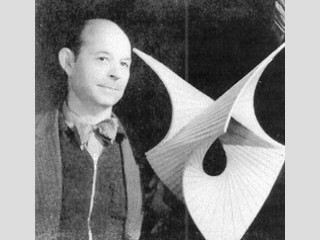
Antoine Pevsner biography
Date of birth : 1886-01-18
Date of death : 1962-04-12
Birthplace : Orel, Russi
Nationality : Russian
Category : Arts and Entertainment
Last modified : 2010-12-13
Credited as : Sculptor and painter, ,
The Russian constructivist sculptor and painter Antoine Pevsner was one of the founders of the ultramodern abstract school in Moscow in the 1920s. His art is severely geometrical, elegant, intellectual, and uncompromising.
Antoine Pevsner was born on Jan. 18, 1886, in Orel, the son of a copper refinery executive. He and his two brothers, Alexei and Naum, were interested in science and specialized in engineering in school. Antoine and Naum (who took the surname Gabo) then turned to art. Pevsner studied at the Academy of Fine Arts in Kiev (1908-1910) and in St. Petersburg (1911). In Moscow he saw the collections of impressionist, Fauve, and cubist art which belonged to Ivan Morosov and Sergei Stchoukine (Shchukin).
In 1912 Pevsner went to Paris, where he saw the cubist art of Pablo Picasso, Georges Braque, and Alexander Archipenko. Pevsner began to paint in 1913. With the outbreak of World War I he joined Gabo in Norway. In 1917 they moved to Moscow, where Pevsner became a member of the faculty at the progressive Fine Arts and Technical School. The presence of Kasimir Malevich and Vladimir Tatlin on the faculty brought Pevsner into contact with suprematism.
Pevsner and Gabo were swept up in the cause of avant-garde art and supported the Revolution as a force for the liberation and promotion of advanced social and artistic programs. They became disenchanted once it was required that art lose its autonomy and be used as a tool to propagate political philosophy. They thought that the constructivists led by Tatlin had become doctrinaire, and so they detached themselves from their former colleagues more and more. They published their position in the 1920 Realistic Manifesto. They stated that there was a need for new art forms and that dynamic rhythms must assume dominance over mass to emphasize space-time relationships and express the modern spirit. Once the Communist government had withdrawn its support and begun to suppress all free artistic expression as "formalism, " artists had the choice of either conforming to official policy or leaving. Pevsner and Gabo left.
Pevsner went to Berlin, where he turned to sculpture and made his first construction. Finding this new experience congenial, he concentrated on sculpture thereafter. In 1924 he settled in Paris. Characteristic of his work at this time are Portrait of Marcel Duchamp (1926) and Torso (1924-1926). He began to use plastics and brass sheeting, which he cut and fixed to a surface to form the effect of a high relief. Light and shadow play an important role in these works. In 1927 he and Gabo collaborated on sets for Sergei Diaghilev's ballet La Chatte.
Pevsner became a French citizen in 1930. The next year he became a founding member of the Abstraction-Creation group. He supported a similar group, Realites Nouvelles, 14 years later. Pevsner's sculpture developed gradually and showed no sharp turns in conception. In the mid and late 1930s he used ribbing on sheet metal to emphasize linear movement, as in Construction for an Airport (1937). In it, parabolically turned planes appear as if activated by some centrifugal force which suggests consumption of space. Later, Pevsner had his works cast in bronze; this gave them a rich consistency unlike that of welded constructions.
In 1948 Pevsner and Gabo had a comprehensive retrospective exhibition at the Museum of Modern Art in New York City. Pevsner produced two works on a monumental scale: Dynamic Projection in the 30th Degree (1950-1951) for University City in Caracas, Venezuela, and Developable Column of Victory (Flight of the Bird, 1955) for the General Motors Technical Center in Warren, Mich. He died in Paris on April 12, 1962.
Recommended are Alexei Pevsner, A Biographical Sketch of My Brothers: Naum Gabo and Antoine Pevsner (trans. 1964), and the catalog of the Museum of Modern Art 1948 exhibition, Naum Gabo, Antoine Pevsner, with an introduction by Herbert Read and brief texts by Ruth Olson and Abraham Chanin.
















